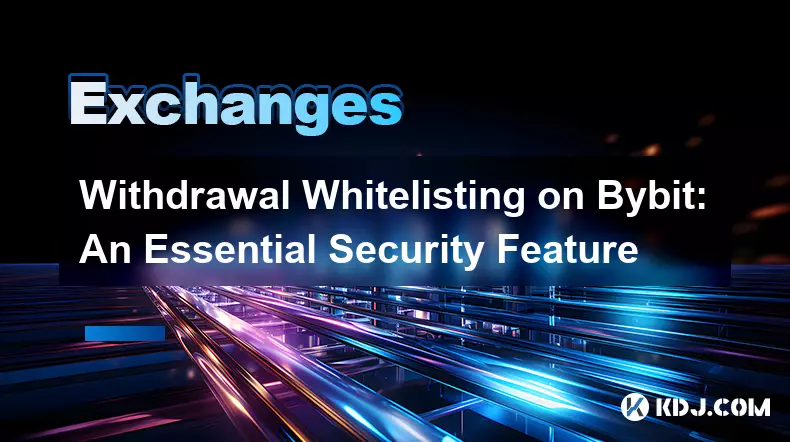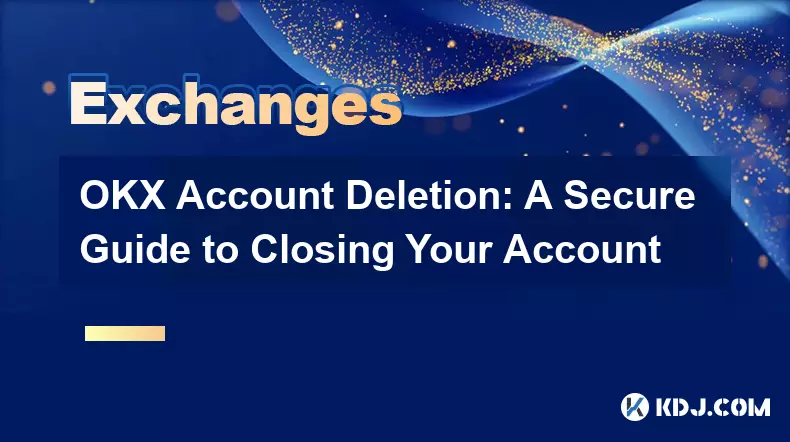-
 bitcoin
bitcoin $101752.865364 USD
-1.09% -
 ethereum
ethereum $3382.985899 USD
-1.38% -
 tether
tether $0.999658 USD
0.04% -
 xrp
xrp $2.272505 USD
-1.51% -
 bnb
bnb $989.089004 USD
0.14% -
 solana
solana $156.962612 USD
-3.08% -
 usd-coin
usd-coin $0.999776 USD
0.01% -
 tron
tron $0.290786 USD
-0.69% -
 dogecoin
dogecoin $0.174594 USD
-2.86% -
 cardano
cardano $0.560085 USD
-3.55% -
 hyperliquid
hyperliquid $40.023704 USD
-5.75% -
 chainlink
chainlink $15.324649 USD
-2.78% -
 bitcoin-cash
bitcoin-cash $493.576540 USD
-3.52% -
 zcash
zcash $571.320038 USD
-12.05% -
 stellar
stellar $0.280066 USD
-4.26%
Withdrawal Whitelisting on Bybit: An Essential Security Feature
Bybit’s withdrawal whitelisting enhances security by allowing fund transfers only to pre-approved addresses, protecting against unauthorized transactions.
Nov 05, 2025 at 06:45 am

Understanding Withdrawal Whitelisting on Bybit
1. Withdrawal whitelisting is a security mechanism implemented by Bybit to protect user funds during cryptocurrency transfers. This feature allows users to pre-approve specific wallet addresses for withdrawals, ensuring that funds can only be sent to trusted destinations. Once enabled, any withdrawal request to an unlisted address will be automatically blocked, significantly reducing the risk of unauthorized transactions.
2. The system operates by requiring users to manually add and verify external wallet addresses through a multi-step authentication process. This includes email confirmation, two-factor authentication (2FA), and in some cases, additional identity verification. Only after completing these steps does the address become active on the whitelist.
3. Enabling withdrawal whitelisting introduces a delay in the withdrawal process—typically 24 hours—for newly added addresses. This cooling-off period acts as a safeguard, giving users time to detect and cancel potential unauthorized changes if their account has been compromised.
4. Users have full control over their whitelist and can manage it directly from the security settings section of their Bybit account. They can add, edit, or remove addresses at any time, though removals may also require confirmation via 2FA and email verification to prevent malicious actors from clearing the list.
5. This feature is particularly valuable for high-volume traders and institutional investors who manage large portfolios. By restricting fund movement to known wallets, they minimize exposure to phishing attacks, social engineering, and malware-based theft attempts.
Why Security Matters in the Crypto Space
1. Cryptocurrency exchanges are prime targets for cybercriminals due to the irreversible nature of blockchain transactions. Once funds are transferred, recovery is nearly impossible, making proactive security measures essential. Withdrawal whitelisting serves as a critical line of defense against such threats.
2. Phishing scams and fake customer support channels often trick users into revealing login credentials or approving unauthorized withdrawals. With whitelisting enabled, even if attackers gain access to an account, they cannot redirect funds to their own wallets unless those addresses are already approved.
3. Malware designed to alter clipboard contents—a common tactic—automatically replaces copied wallet addresses with attacker-controlled ones. Whitelisting prevents this attack vector by rejecting transactions to non-approved destinations, preserving the integrity of every withdrawal attempt.
4. Exchange breaches, while rare on major platforms like Bybit, do occur across the industry. Having layered security protocols ensures that user assets remain protected even if backend systems face vulnerabilities or insider threats.
5. Regulatory bodies increasingly emphasize the importance of self-custody practices and robust exchange-level protections. Features like withdrawal whitelisting align with best practices recommended by cybersecurity experts and financial regulators alike.
How to Set Up and Manage Your Whitelist
1. Log in to your Bybit account and navigate to the 'Security' tab under your profile settings. Locate the 'Withdrawal Whitelist' option and click 'Enable.' You'll be prompted to confirm your identity using 2FA and email verification.
2. To add a new address, select 'Add Address' and enter the destination wallet details, including network type (e.g., ERC-20, BEP-20). Choose the appropriate coin and ensure the network matches both the sending and receiving wallets to avoid loss of funds.
3. After submission, Bybit sends a confirmation link to your registered email. Click the link and complete the 2FA challenge to initiate the 24-hour waiting period. During this time, the address remains inactive and cannot receive withdrawals.
4. Once the waiting period ends, the address becomes active and appears in your whitelist dashboard. You can view its status, last usage date, and associated coin types. Any withdrawal request to this address will proceed normally after standard authentication.
5. For enhanced safety, consider maintaining separate whitelisted addresses for different purposes—such as cold storage, trading accounts, and payment processing—and review the list regularly to remove outdated entries.
Frequently Asked Questions
What happens if I try to withdraw to a non-whitelisted address?Bybit will block the transaction immediately. An error message will appear stating that the destination address is not on the approved list. No funds are deducted, and the withdrawal request is canceled.
Can I disable withdrawal whitelisting once it’s enabled?Yes, users can disable the feature at any time through the security settings. However, doing so increases vulnerability to unauthorized withdrawals. It is strongly advised to keep it active, especially for accounts holding significant balances.
Does the 24-hour waiting period apply to all address changes?The waiting period applies only to newly added addresses. Modifications to existing entries, such as labeling or deleting, do not trigger the delay but still require 2FA and email confirmation for authorization.
Is withdrawal whitelisting available for all cryptocurrencies on Bybit?Whitelisting supports most major cryptocurrencies offered on the platform, including Bitcoin, Ethereum, USDT, and others. Availability depends on the specific coin and network, so users should verify compatibility before initiating setup.
Disclaimer:info@kdj.com
The information provided is not trading advice. kdj.com does not assume any responsibility for any investments made based on the information provided in this article. Cryptocurrencies are highly volatile and it is highly recommended that you invest with caution after thorough research!
If you believe that the content used on this website infringes your copyright, please contact us immediately (info@kdj.com) and we will delete it promptly.
- Ripple (XRP) in 2026: Hold or Fold? A Look at XRP's Future and Emerging DeFi Alternatives
- 2025-11-08 18:35:01
- Zcash ZEC Coin Price Explosion: From Privacy Niche to Center Stage
- 2025-11-08 18:55:01
- Berachain Price Prediction: Navigating the Honeycomb Hype in Crypto
- 2025-11-08 18:55:01
- Arthur Hayes, Gold, and Bitcoin: A Modern Monetary Trinity?
- 2025-11-08 19:15:01
- Shiba Inu's Next Move: Navigating a Shifting Market
- 2025-11-08 19:20:01
- Pakistan's Crypto Crossroads: Balancing Opportunity with Asset-Backed Realities
- 2025-11-08 19:20:01
Related knowledge

Common Mistakes to Avoid on OKX: A Guide for New Traders
Nov 04,2025 at 03:37pm
Understanding the Interface Before Trading1. New traders often jump into placing orders without fully exploring the OKX platform layout. Taking time t...

OKX TradingView Integration: A Guide to Advanced Chart Analysis
Nov 02,2025 at 03:37am
OKX and TradingView: Bridging the Gap for Professional Traders1. OKX, one of the leading cryptocurrency exchanges, has integrated with TradingView to ...

Finding Your OKX Deposit Address: A Quick and Safe Guide
Nov 05,2025 at 01:15pm
Finding Your OKX Deposit Address: A Step-by-Step Process1. Log into your OKX account using your registered credentials. Ensure you are accessing the o...

OKX Savings Guide: A Low-Risk Strategy for Earning Crypto
Nov 05,2025 at 06:55am
Understanding OKX Savings and Its Role in Crypto Earnings1. OKX Savings offers users a straightforward method to earn passive income by leveraging idl...

OKX Account Deletion: A Secure Guide to Closing Your Account
Nov 05,2025 at 08:44am
Understanding the Implications of Account Closure1. Closing your OKX account permanently removes access to all associated trading features, including ...

Mastering the OKX Mobile App: Tips for Trading on the Go
Nov 05,2025 at 01:19am
Streamlined Navigation for Efficient Trading1. The OKX mobile app features a clean and intuitive interface that allows traders to access key functions...

Common Mistakes to Avoid on OKX: A Guide for New Traders
Nov 04,2025 at 03:37pm
Understanding the Interface Before Trading1. New traders often jump into placing orders without fully exploring the OKX platform layout. Taking time t...

OKX TradingView Integration: A Guide to Advanced Chart Analysis
Nov 02,2025 at 03:37am
OKX and TradingView: Bridging the Gap for Professional Traders1. OKX, one of the leading cryptocurrency exchanges, has integrated with TradingView to ...

Finding Your OKX Deposit Address: A Quick and Safe Guide
Nov 05,2025 at 01:15pm
Finding Your OKX Deposit Address: A Step-by-Step Process1. Log into your OKX account using your registered credentials. Ensure you are accessing the o...

OKX Savings Guide: A Low-Risk Strategy for Earning Crypto
Nov 05,2025 at 06:55am
Understanding OKX Savings and Its Role in Crypto Earnings1. OKX Savings offers users a straightforward method to earn passive income by leveraging idl...

OKX Account Deletion: A Secure Guide to Closing Your Account
Nov 05,2025 at 08:44am
Understanding the Implications of Account Closure1. Closing your OKX account permanently removes access to all associated trading features, including ...

Mastering the OKX Mobile App: Tips for Trading on the Go
Nov 05,2025 at 01:19am
Streamlined Navigation for Efficient Trading1. The OKX mobile app features a clean and intuitive interface that allows traders to access key functions...
See all articles





















![The Graph Price Prediction [GRT Crypto Price News Today] The Graph Price Prediction [GRT Crypto Price News Today]](/uploads/2025/11/07/cryptocurrencies-news/videos/690d4df44fe69_image_500_375.webp)



















































